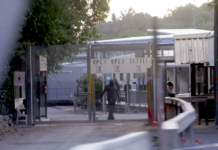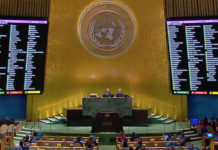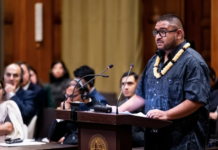By Basten Gokkon in Pontianak, West Kalimantan
A timber plantation company is illegally clearing one of Indonesia’s last coastal peat swamp forests, a carbon reservoir and biodiversity hotspot home to hundreds of endangered orangutans, say observers who are appealing to President Joko Widodo’s administration to intervene.
The company, PT Mohairson Pawan Khatulistiwa (MPK), did not respond to numerous requests for comment. But locals report the firm is digging a drainage canal through the peat soil in alleged violation of a moratorium on peatland development enshrined by Jokowi, as he is known, into law last December.
Draining peat soil — a deposit of decaying organic matter that can extend deep below the ground’s surface — is a prerequisite to planting it with the fast-growing pulpwood species that feed Indonesia’s paper mills, a huge industry in the archipelago country.
But the practice dries out the soil, rendering the peat highly flammable. Its widespread usage is the main underlying cause of Indonesia’s annual fires which often reach crisis proportions. In 2015, they made half a million people sick and pumped more carbon into the atmosphere than the entire EU during the same period.
A man who lives near the area PT MPK has been licensed to develop, and within the Sungai Putri forest block in question, confirmed the canal has reached eight kilometers in length and counting.
“The canal development is even at the moment going on and I’m sure by next week it will have reached more areas,” he said by phone last week, asking to remain anonymous for fear of reprisal.
“From what I’ve witnessed myself, there are two excavators operating to build the canal and some workers in the field. These activities kicked off around late December, but it only appeared clear what they were doing in January through March.”
The Sungai Putri landscape covers some 55,000 hectares in the Ketapang district of West Kalimantan province, along the southwestern coast of Borneo island. The area consists almost completely of peat, some of it many meters deep, according to a 2008 report by Fauna and Flora International.
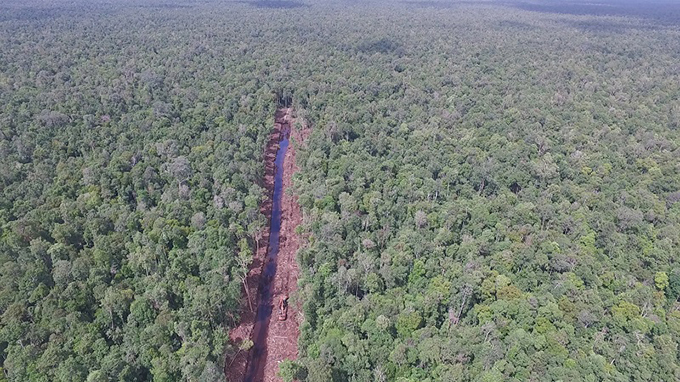
“I went back there in 2009 and also 2014, and yes, it’s still peat,” Gusti Anshari, the Tunjung Pura University professor who conducted the study, said in an interview.
Sungai Putri supports an estimated 900-1,250 orangutans, “one of the largest unprotected populations in the whole of Indonesia,” according to a 2016 joint report by the Borneo Nature Foundation and International Animal Rescue. The Bornean orangutan (Pongo pygmaeus) is listed as Critically Endangered by the IUCN.
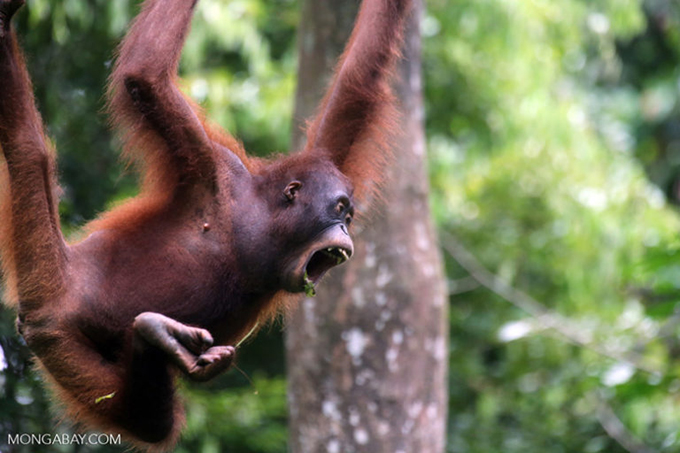
Potentially at issue is how much of PT MPK’s concession is forested. The firm’s permit area overlaps largely with the Sungai Putri landscape studied by researchers.
Company documents obtained by Mongabay cite a figure of 35.1 percent forest coverage in the concession. The rest of the area is said to consist of mostly “scrub swamp” and “shrub swamp.”
The figures appear in a 2015 letter to PT MPK from the Ministry of Environment and Forestry; the letter suggests the data was produced by a consultant hired by the firm. (The permit was issued by the Ministry of Forestry in 2008, before it was combined with the Ministry of Environment.)
But researchers insist that much more of the area is forested.
“A 2016 satellite image confirms findings from a detailed 2007 vegetation study in Sungai Putri that about 58 percent of the 48,440 hectare license area remains covered in tall peat swamp forest and the remainder in medium height swamp forest, heath forest, and hill forest,” conservation biologist Erik Meijaard, who coordinates the Borneo Futures Initiative, wrote in a recent op-ed for Mongabay.
“Those estimates are still pretty accurate. When I was recently standing on a hill overlooking the area, I can say that for sure this is an extensive forest area, a bit damaged and degraded near the edges but certainly with tall forest in most of the remainder.”
He added in an interview: “If the conversion license was given out on the basis of wrong information, it needs to be retracted. It is the government’s responsibility to ensure that their processes are fair and lawful.”
The Rainforest Action Network has launched a petition demanding that President Jokowi intervene.
Gemma Tillack, the NGO’s chief agribusiness campaigner, called Sungai Putri “critical forest ecosystem” that “must be protected from palm oil and pulp development. Its intact peat forests are a source of livelihoods for local communities and important habitat” for the Bornean orangutan.
The Peatland Restoration Agency (BRG), which answers to the president, has been asked to independently verify the area’s physical characteristics in order to clear up any confusion.
Asked if the agency was aware of the canal development, BRG deputy Myrna Safitri said in an email that her side had met twice with the company and that it had agreed to change its logging plan under the supervision of the forestry ministry, after which a ground check would take place. She did not reply to a follow-up inquiry asking for specifics.
It remains unclear who owns PT MPK, although recent comments by Ketapang district head Martin Rantan suggest a link to a Chinese-owned investment firm. The Chinese Chamber of Commerce in Jakarta did not answer a request for comment.

Marcellinus Tjawan, head of the West Kalimantan Forestry Office, said he was taking the initiative to establish Sungai Putri as a protected area, but obstacles remained.
“All concerns about the environment and natural resources management certainly gets our full attention, but this is definitely not as easy as looks, particularly knowing the fact that permits from the central government are involved,” he said.
The Forestry Ministry did not respond to a request for comment.
Meijaard called for the company to cease and desist while stakeholders determine what to do.
“Maybe the deforested fringes of Sungai Putri can be developed for plantations so that the land use is stabilised and some of the revenues are used to protect the forested center,” he said.
“Maybe companies around Sungai Putri can contribute to the long term management of Sungai Putri’s core forest areas. But first we need to stop the needless destruction of the area.”
Mongabay.com seeks to raise interest in and appreciation of wild lands and wildlife, while examining the impact of emerging trends in climate, technology, economics, and finance on conservation and development. This article is republished under a Creative Commons licence BY-NC-ND.





